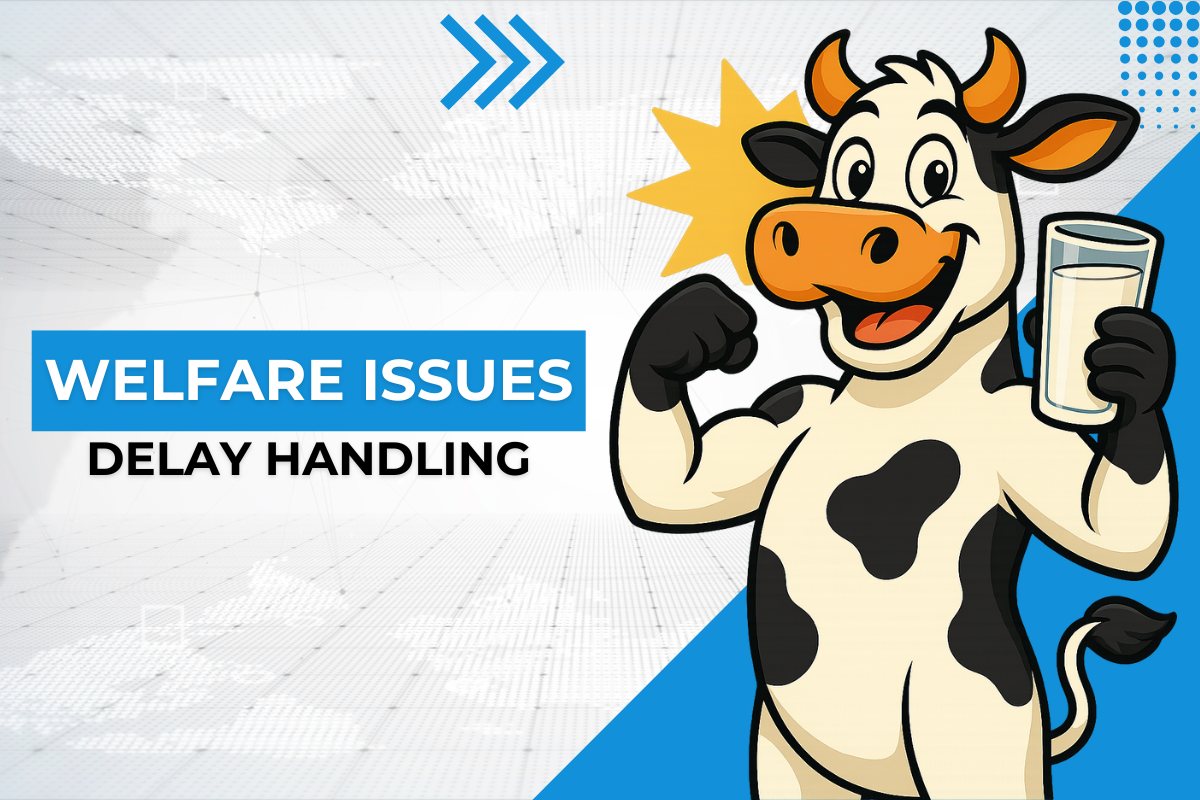The 30-second problem costing you everything
Labor costs eat up 20% or more of total milk production expenses on most dairy farms. But poor animal welfare makes those costs even higher.
When cows are stressed or poorly handled, they don't cooperate. Workers spend more time fighting with difficult cows instead of efficiently milking cooperative ones. The milking process accounts for 25-50% of total hours worked on a farm, so any time waste here multiplies across your entire operation.
At Cattle Care, we've analyzed how welfare problems create labor inefficiency. Stressed cows mean slower workers, longer milking times, and higher labor costs per cow.
Difficult cows take longer to handle
Stressed cows resist every step of the milking process. They don't want to enter the parlor, they fight positioning, and they won't stand still during milking.
This resistance adds seconds to every interaction. A few extra seconds per cow doesn't sound like much, but it adds up fast when you're milking hundreds or thousands of cows daily.
Workers spend extra time coaxing resistant cows into the parlor. Positioning stressed cows takes multiple attempts instead of one smooth movement. Restless cows require constant repositioning during milking.
Larger operations can achieve 1,000 pounds of milk per hour of labor, while smaller operations only hit 200-400 pounds per hour. The difference? Efficiency at every step, including cow cooperation.
Welfare problems create safety risks
Recent injury data shows that 13% of agriculture-related injuries come from cows, the second most common cause of farm-related injuries on dairy operations.
Stressed cows are unpredictable. They kick, move suddenly, and create dangerous situations. When workers worry about getting hurt, they work more carefully, which means working more slowly.
Workers approach stressed cows cautiously, taking extra time. Defensive positioning during milking adds seconds to each cow. Injury incidents stop work completely while someone gets medical attention.
Moving cows to stressful procedures increases fear behaviors, forceful interactions, and injury risks. Poor welfare makes workers' jobs harder and more dangerous.
Inconsistent handling wastes training time
When different workers handle cows differently, it creates confusion that slows everyone down. Cows don't know what to expect, and new workers can't learn consistent procedures.
New workers take longer to learn when procedures aren't standardized. Supervisors must spend more time monitoring and correcting techniques. Worker turnover increases when jobs are harder than necessary.
Better animal handling practices reduce both welfare problems and worker challenges. When procedures are clear and consistent, training is faster.
Repeat handling kills productivity
Poor welfare often means handling cows multiple times for the same task. A cow that won't enter needs to be retrieved. A restless cow during milking needs repositioning. A stressed cow might not milk out completely, requiring additional attention.
Workers make multiple trips to move resistant cows. Incomplete milking sessions require workers to return to the same cow. Stressed cows need extra attention that takes time from other tasks.
The most efficient operations handle each cow once, smoothly, without issues.
Poor welfare increases total labor needs
When welfare problems slow down individual workers, farms need more total labor hours to milk the same number of cows. More labor hours means higher costs.
Some operations add more workers. Others push existing workers faster, which often leads to rougher handling and worse welfare, creating a cycle that makes efficiency worse.
More hours are needed to milk the same number of cows. Higher total payroll costs for the same milk production. Overtime expenses when regular hours aren't enough.
Labor efficiency varies widely even within similar herd sizes. The farms with the best efficiency have smooth, consistent handling that keeps cows calm and cooperative.
The real cost nobody's calculating
Here's what most farms miss: they track total labor hours, but they don't track wasted labor hours.
Take a 1,000-cow operation where welfare problems add just 30 seconds per cow. That's 500 minutes of wasted time per milking session. Multiply that by three milkings daily, and you've burned through 25 hours of labor every single day on nothing but fighting with stressed cows.
At $15 per hour, that's $375 in daily wages going to waste. Not going to productive work, just managing preventable welfare problems.
Over a year? That's $136,875 in labor costs spent fixing problems instead of milking cows efficiently.
And that's the conservative estimate. Many operations see 45-60 seconds of extra handling time per stressed cow, which doubles or triples these losses. This calculation doesn't include the cost of injuries, worker turnover, or the milk production you lose when stressed cows don't let down properly.
The labor efficiency leak from poor welfare isn't a small problem. It's bleeding your operation of real money every single shift.
Fixing the leak
The solution isn't pushing workers to go faster. It's removing the welfare problems that slow them down.
OmniCow identifies the welfare issues that create labor inefficiency. Our AI monitoring spots rough handling, inconsistent procedures, and cow stress behaviors that waste worker time.
When cows are calm and well-handled, workers do their jobs efficiently. Parlor flow improves, milking time drops, and labor costs per cow decrease.
Better welfare isn't just good for cows. It's good for labor efficiency and your bottom line.
👉 Fix the leak today. Book a call here to see how OmniCow will help your operation and start saving thousands in wasted labor costs.




